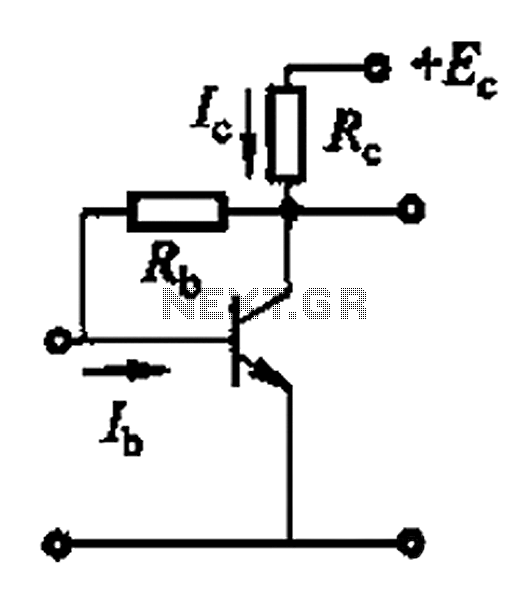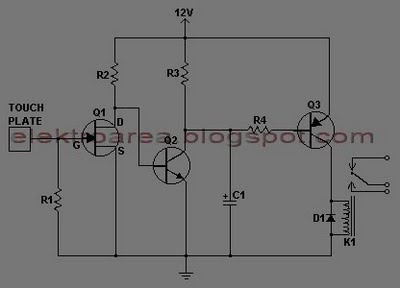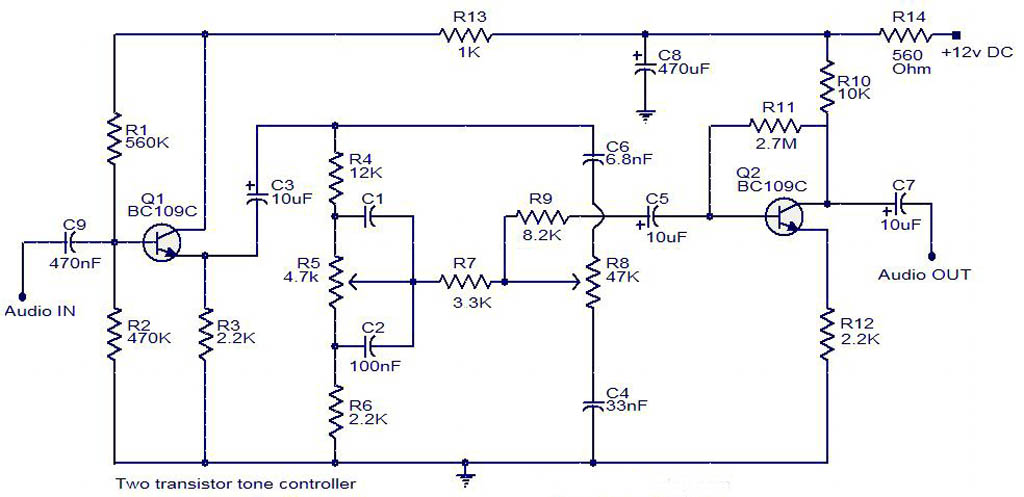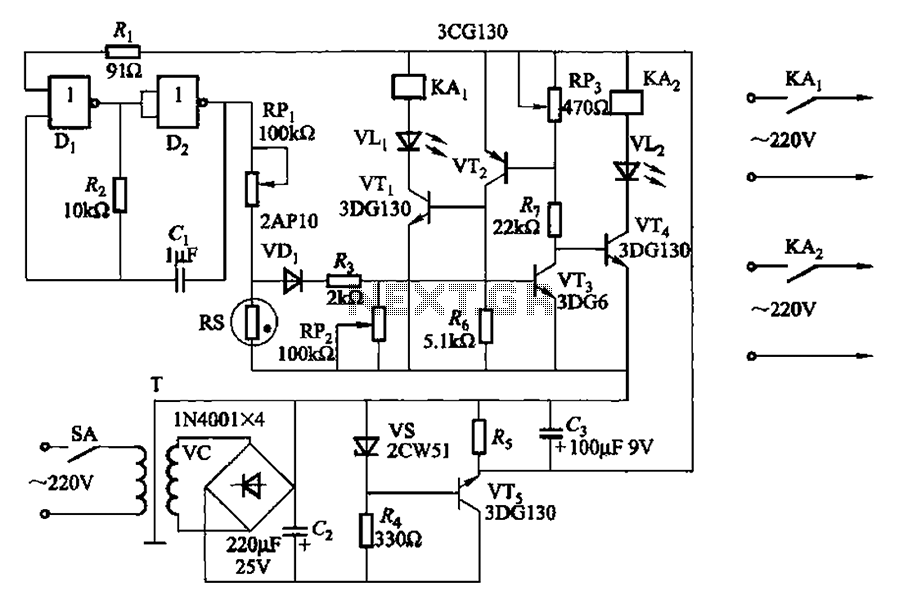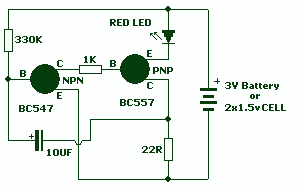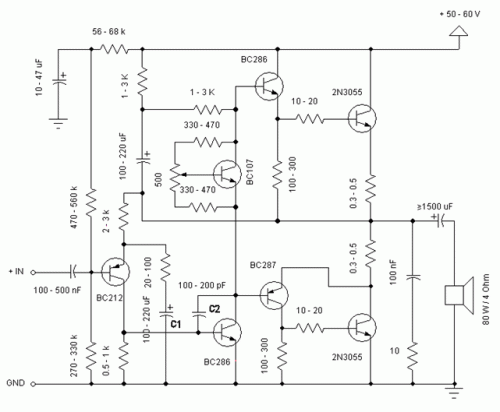
6 Transistor Tildens H-Bridge
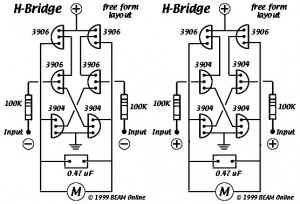
This diagram illustrates the 6-transistor Tilden H-bridge circuit. While it is not as old as the original basic H-bridge, it has a significant history and serves as the foundation for many BEAM driver circuits. Revised drawings were created for Ian some time ago for posting on beam-online, although they were not published amid numerous revisions. Two circuit versions are included: one that activates with a positive input and another for quadcores that activates with a negative input. Ian indicates using 100k input resistors, but 47k resistors have proven effective in practice. Tilden's report suggests a minimum of 50k, with a range up to approximately 20 Meg.
The following diagram represents a 16W audio amplifier circuit built using two LM383 power ICs in a bridge configuration, classifying it as a bridge amplifier. The LM383 is discontinued, making it challenging to source; alternatives include ECG1232, TDA2002, or TDA2003. The parts list includes: R1, R2, R4, R5 = 270Ω; R3 = 2.7Ω; VR1 = 10KΩ logarithmic potentiometer; TR1 = 470KΩ trimmer; IC1, IC2 = LM388; C1 = 100µF/25V; C2 = 100nF; C3 = 10µF/25V; C4, C5 = 22µF/25V; C6 = 47nF.
Additionally, a 4W bridge amplifier circuit design based on the LM388 power IC is presented, featuring two chips. This circuit diagram depicts an amplifier with four input channels and four output channels, commonly referred to as a quad amplifier. It is specifically designed for car audio systems, providing significant output power per channel, low distortion, and low output noise, making it suitable for simple car amplifiers.
A simple bridge amplifier circuit based on the TDA7240A is also included, intended for car audio systems but adaptable for small home audio applications. The TDA7240A is a 20W bridge audio amplifier IC designed specifically for car radio applications, requiring few external components.
The circuit diagram of the Vox Tone Bender Pedal is similar to that of the Fuzz Face pedal, offering more treble response to enhance the sound of typically "dark" British amplifiers.
Lastly, a circuit consisting of an infrared transmitter-receiver pair utilizes IR beam transmission to control a toy car, enabling it to switch on or off. Modifications can be made to allow the toy car to turn left or right.
The comprehensive nature of these designs highlights their versatility and application in various audio and control systems. Each circuit serves a unique function, from amplifying audio signals to controlling devices wirelessly. The included parts lists ensure that builders can source the necessary components for successful implementation, while the detailed descriptions of each circuit provide insights into their operational principles and intended uses.This diagram is certainly the 6 transistor Tilden H-bridge circuit; while not as old as the original basic H-bridge, this goes way back, and will be the basis for a lot of BEAM driver circuits. I did a few revised drawings for Ian quite a while back, so he could place them up at beam-online. However, they did not get posted inside the midst of the a lot of revisions he was doing. Attached (begging Ian`s indulgence), will be the two versions of the circuit, one which turns on having a Positive input, the other (for quadcores) having a Negative input. Ian shows 100k input resistors. I`ve been applying 47k resistors with success. Tilden`s report recommends nothing lower than 50k (I assumed 47k was near enough) and up to 20 Meg or so.
The following diagram is 16W audio amplifier circuit. The circuit built based 2 pieces of power IC LM383 in bridge connection, so this amplifier is an bridge amplifier. This is an old amplifier, LM383 is discontinued, so this LM383 might be difficult to find. You can use ECG1232, TDA2002 or TDA2003 as the replace for. Parts List: R1-2-4-5=270 © R3 = 2. 7 © VR1 = 10K © Log. Pot. TR1 = 470K © Trimmer IC1-2 = LM388 C1 = 100uF/25V C2 = 100nF C3 = 10uF/25V C4-5 = 22uF/25V C6 = 47nF This is the 4W bridge amplifier circuit design based on power IC LM388 as the main component.
Currently there are 2 chips. Here`s a circuit diagram of an amplifier that has four input channels and four output channels or commonly called the quad amplifier. Power amplifier is designed specifically for car audio system applications. With a fairly large output power per channel, low distortion and low output noise features; amplifier is suitable for your car simple amplifier.
This is a simple bridge amplifier based on TDA7240A. This circuit is designed for car audio system, but you may use this circuit for your small home audio application. :) Schematic Diagram: PCB Layout: About TDA7240A: The TDA7240A is a 20W bridge audio amplifier IC designed specially for car radio applications.
The low external component. This is the circuit diagram of Vox Tone Bender Pedal. The circuit is very similar to Fuzz Face pedal. The Vox ToneBender will have a lot more treble response than the Fuzz Face. maybe to help brighten up those characteristically "dark" sounding British amps some. Using a Vox ToneBender with a Fender Twin, or any other. The circuit, consisting of an infrared transmitter-receiver pair, utilizes IR beam transmission to switch the toy car on` or off`, yeah. it will be only switching on and switching off, you may modify this circuit to make the toy car to turn left or right.
To operate the toy car, you have to hold the. 🔗 External reference
The following diagram represents a 16W audio amplifier circuit built using two LM383 power ICs in a bridge configuration, classifying it as a bridge amplifier. The LM383 is discontinued, making it challenging to source; alternatives include ECG1232, TDA2002, or TDA2003. The parts list includes: R1, R2, R4, R5 = 270Ω; R3 = 2.7Ω; VR1 = 10KΩ logarithmic potentiometer; TR1 = 470KΩ trimmer; IC1, IC2 = LM388; C1 = 100µF/25V; C2 = 100nF; C3 = 10µF/25V; C4, C5 = 22µF/25V; C6 = 47nF.
Additionally, a 4W bridge amplifier circuit design based on the LM388 power IC is presented, featuring two chips. This circuit diagram depicts an amplifier with four input channels and four output channels, commonly referred to as a quad amplifier. It is specifically designed for car audio systems, providing significant output power per channel, low distortion, and low output noise, making it suitable for simple car amplifiers.
A simple bridge amplifier circuit based on the TDA7240A is also included, intended for car audio systems but adaptable for small home audio applications. The TDA7240A is a 20W bridge audio amplifier IC designed specifically for car radio applications, requiring few external components.
The circuit diagram of the Vox Tone Bender Pedal is similar to that of the Fuzz Face pedal, offering more treble response to enhance the sound of typically "dark" British amplifiers.
Lastly, a circuit consisting of an infrared transmitter-receiver pair utilizes IR beam transmission to control a toy car, enabling it to switch on or off. Modifications can be made to allow the toy car to turn left or right.
The comprehensive nature of these designs highlights their versatility and application in various audio and control systems. Each circuit serves a unique function, from amplifying audio signals to controlling devices wirelessly. The included parts lists ensure that builders can source the necessary components for successful implementation, while the detailed descriptions of each circuit provide insights into their operational principles and intended uses.This diagram is certainly the 6 transistor Tilden H-bridge circuit; while not as old as the original basic H-bridge, this goes way back, and will be the basis for a lot of BEAM driver circuits. I did a few revised drawings for Ian quite a while back, so he could place them up at beam-online. However, they did not get posted inside the midst of the a lot of revisions he was doing. Attached (begging Ian`s indulgence), will be the two versions of the circuit, one which turns on having a Positive input, the other (for quadcores) having a Negative input. Ian shows 100k input resistors. I`ve been applying 47k resistors with success. Tilden`s report recommends nothing lower than 50k (I assumed 47k was near enough) and up to 20 Meg or so.
The following diagram is 16W audio amplifier circuit. The circuit built based 2 pieces of power IC LM383 in bridge connection, so this amplifier is an bridge amplifier. This is an old amplifier, LM383 is discontinued, so this LM383 might be difficult to find. You can use ECG1232, TDA2002 or TDA2003 as the replace for. Parts List: R1-2-4-5=270 © R3 = 2. 7 © VR1 = 10K © Log. Pot. TR1 = 470K © Trimmer IC1-2 = LM388 C1 = 100uF/25V C2 = 100nF C3 = 10uF/25V C4-5 = 22uF/25V C6 = 47nF This is the 4W bridge amplifier circuit design based on power IC LM388 as the main component.
Currently there are 2 chips. Here`s a circuit diagram of an amplifier that has four input channels and four output channels or commonly called the quad amplifier. Power amplifier is designed specifically for car audio system applications. With a fairly large output power per channel, low distortion and low output noise features; amplifier is suitable for your car simple amplifier.
This is a simple bridge amplifier based on TDA7240A. This circuit is designed for car audio system, but you may use this circuit for your small home audio application. :) Schematic Diagram: PCB Layout: About TDA7240A: The TDA7240A is a 20W bridge audio amplifier IC designed specially for car radio applications.
The low external component. This is the circuit diagram of Vox Tone Bender Pedal. The circuit is very similar to Fuzz Face pedal. The Vox ToneBender will have a lot more treble response than the Fuzz Face. maybe to help brighten up those characteristically "dark" sounding British amps some. Using a Vox ToneBender with a Fender Twin, or any other. The circuit, consisting of an infrared transmitter-receiver pair, utilizes IR beam transmission to switch the toy car on` or off`, yeah. it will be only switching on and switching off, you may modify this circuit to make the toy car to turn left or right.
To operate the toy car, you have to hold the. 🔗 External reference
Warning: include(partials/cookie-banner.php): Failed to open stream: Permission denied in /var/www/html/nextgr/view-circuit.php on line 713
Warning: include(): Failed opening 'partials/cookie-banner.php' for inclusion (include_path='.:/usr/share/php') in /var/www/html/nextgr/view-circuit.php on line 713
